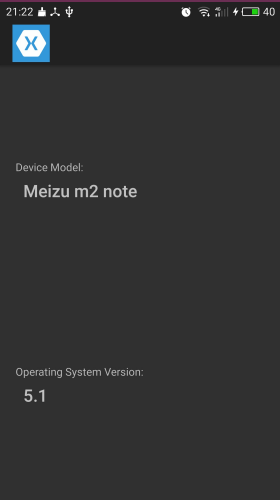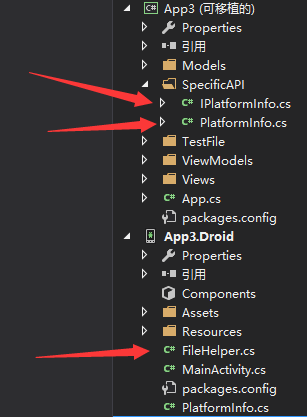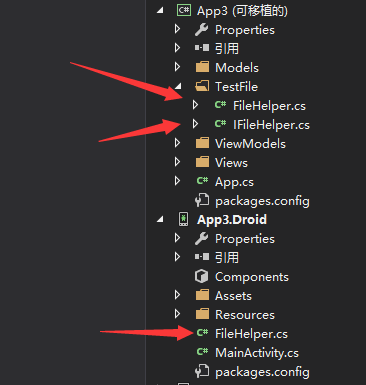Xamarin.Forms学习之Platform-specific API和文件操作
这篇文章的分享原由是由于上篇关于Properties的保存不了,调用SavePropertiesAsync()方法也不行,所以我希望通过操作文件的方式保存我的需要的数据,然后我看了一下电子书中的第二十章和需要相关知识的第九章,这篇文章中的内容则是我学习这两章的一点记录和分享,还是那样,有错请留言指正,谢谢!
不同的平台存在着一些特定的API,通过在电子书中两章的学习,实践一下如何调用这些API和将这些API封装成公共的库,供以后的项目调用。以一个显示平台信息的小实例开始做一个简单的演示,其运行效果如下:

C#代码如下(就是电子书中的实例,只不过只有IOS和Android的):
<?xml version="1.0" encoding="utf-8" ?> <ContentPage xmlns="http://xamarin.com/schemas/2014/forms" xmlns:x="http://schemas.microsoft.com/winfx/2009/xaml" x:Class="App3.Views.DisplayModelAndVersion"> <StackLayout Padding="20"> <StackLayout VerticalOptions="CenterAndExpand"> <Label Text="Device Model:" /> <ContentView Padding="10, 0, 0, 0"> <Label x:Name="modelLabel" FontSize="Large" FontAttributes="Bold" /> </ContentView> </StackLayout> <StackLayout VerticalOptions="CenterAndExpand"> <Label Text="Operating System Version:" /> <ContentView Padding="10, 0, 0, 0"> <Label x:Name="versionLabel" FontSize="Large" FontAttributes="Bold" /> </ContentView> </StackLayout> </StackLayout> </ContentPage> #if __IOS__ using UIKit; #elif __ANDROID__ using Android.OS; #endif namespace App3.Views
{ public partial class DisplayModelAndVersion: ContentPage { public PlatInfoSap1Page () { InitializeComponent (); #if __IOS__ UIDevice device = new UIDevice(); modelLabel.Text = device.Model.ToString(); versionLabel.Text = String.Format("{0} {1}", device.SystemName, device.SystemVersion); #elif __ANDROID__ modelLabel.Text = String.Format("{0} {1}", Build.Manufacturer, Build.Model); versionLabel.Text = Build.VERSION.Release.ToString(); #endif } } }
记得在程序集中添加对Mono.Android和Xamarin.IOS的引用。
也许只有这一个,你看不出很麻烦,但是如果你要调用更多的特定的API,那么可以想见,你的代码中将会有许多的“#if __IOS__ xxxxx #elif __ANDROID__ xxxxxx #endif”这样的代码,那能不能把这些特定的API封装在其相应的平台,实现分平台的调用呢,当然是可以的。。。。。。我就不写其他的废话,就是通过DependencyService来实现的,直接上代码:

添加如上图所的接口和类(Sorry,下面那个箭头搞错了)
public interface IPlatformInfo { string GetModel(); string GetVersion(); } public class PlatformInfo { IPlatformInfo fileHelper = DependencyService.Get<IPlatformInfo>(); public string GetModel() { return fileHelper.GetModel(); } public string GetVersion() { return fileHelper.GetVersion(); } } [assembly: Dependency(typeof(App3.Droid.PlatformInfo))] namespace App3.Droid { class PlatformInfo : IPlatformInfo { public string GetModel() { return string.Format("{0} {1}", Build.Manufacturer, Build.Model); } public string GetVersion() { return Build.VERSION.Release; } } }
记住DependencyService和Dependency的命名空间是Xamarin.Froms,我开始没注意就被坑了。IOS的代码没有什么变化,就是命名空间变了,就不贴出来了,我也没写。。。
当你看到“assembly: Dependency”这个的时候,你也许就联想到了反射--是的,就是通过反射。建议大家在实现相关的功能是首先使用DependencyService,至于原因我就不用我蹩脚的英语给大家翻译了,直接上原文:
DependencyService is not the only way to implement platform-specific calls in a PCL. Adventurous developers might want to use dependency-injection techniques to configure the PCL to make calls into the platform projects. But DependencyService is very easy to use, and it eliminates most reasons to use a Shared Asset Project in a Xamarin.Forms application.
现在我们继续说说如何把这些设置成公共的库,便于以后的项目调用,其实很简单,就像我们新建一个Xamarin.Froms项目一样,新建一个Xamarin.Platfrom.Tools项目,然后把上面PlatformInfo相关的类和接口再写一遍,建议再添加一个Init的cs文件,代码中不用实现什么具体的东西,其功能就是确保dll正确的加载了。
对于文件的操作,电子书中有个小标题“Good news and bad news”,当中的主要内容就是告诉大家操作文件的是System.IO命名空间(该命名空间下还有个FileInfo类)下的File类在Android和IOS是可以共用的,但是在Windows的三个平台不行,最明显的一个区别就是Windows的三个平台的文件操作是异步的,做过WP开发的应该知道。鉴于目前的移动端的情形,和使用Xamarin开发的主要需求,那个”bad news“我们基本可以忽略了(开发Windows的还是用UWP吧)。
在移动端,基本上都包含一些基本的文件夹,比如Pictures、Music等这些都是公共的,而APP所访问的文件夹和文件还有一个限制,在WP开发中有个名词叫“隔离存储”或者“独立存储”,IOS和Android我并没有太多的接触,但这方面应该都是大体相同的,所以每个应用程序都除了能访问前面说的公共的文件夹和文件之外,都只能访问自己的程序“域”下面的文件夹和文件,做过移动开发或者了解移动开发的应该都知道。对于这些文件夹,Xamarin定义一个SpecialFolder的枚举,其中的MyDocuments就是我们自己的APP才能访问的。通过下面的示例继续:

添加如上图所示的红色箭头的类和接口,代码如下(限于文章的篇幅,我就不贴整个代码,只上GetFiles的):
namespace App3.TestFile { public interface IFileHelper { IEnumerable<string> GetFiles();
} } namespace App3.TestFile { public class FileHelper { IFileHelper fileHelper = DependencyService.Get<IFileHelper>(); public IEnumerable<string> GetFiles() { return fileHelper.GetFiles(); }
} }
[assembly: Dependency(typeof(App3.Droid.FileHelper))]
namespace App3.Droid
{
class FileHelper : IFileHelper
{
public IEnumerable<string> GetFiles()
{
// Sort the filenames.
//string path = GetDocsFolder();
//IEnumerable<string> filenames =
// from filepath in new List<string> { path }
// select filepath;
IEnumerable<string> filenames =
from filepath in Directory.EnumerateFiles(GetDocsFolder())
select filepath;
return filenames;
}
string GetDocsFolder()
{
return Environment.GetFolderPath(Environment.SpecialFolder.MyDocuments);
}
}
}
至于XAML呢么就是一个简单的ListView,这个倒没什么说的。大家自己试一试吧。
这里的文件操作能满足我们许多的需求了,但是有时候我们在项目中添加一个图片、文件或者其他的,该怎么办呢。。。下次再说操作本地文件的事吧!
其实最开始的那版文字描述更通顺一些,结果出去吃了饭,回来发现没有自动保存,而且以前写的忘了,然后又重新写了,现在自己读了一次。。。
对了,.net core发布了,最近也在摸索,相比于Xamarin,分享和关注的人也更多,学习起来还是很方便的,上周自己也买了一个最便宜的阿里云的在玩,无语啊,linux也成必学的了,伤心~共勉!



 浙公网安备 33010602011771号
浙公网安备 33010602011771号